Power Plan Sent to the Cleaners
Air Date: Week of October 13, 2017
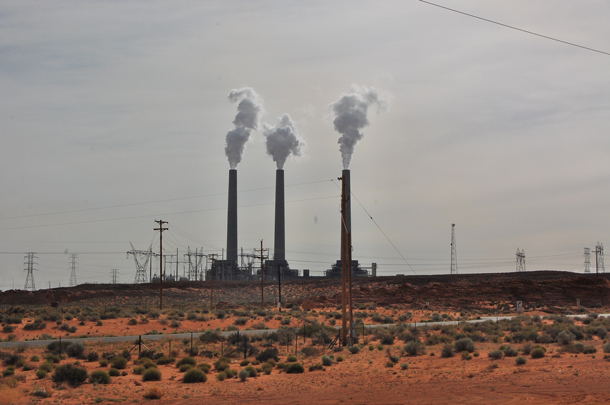
The Navajo Generating Station in Page, Arizona is one of the nation’s largest coal-fired power plants. Citing high costs to keep the plant running, the utilities that own the Navajo Generating Station voted in early 2017 to close the facility when the lease expires in 2019. (Photo: ilya_ktsn, Flickr CC BY-NC 2.0)
EPA Administrator Scott Pruitt has started to rollback the Clean Power Plan, President Obama’s signature policy to curb carbon emissions from power plants. As Vermont Law Professor Pat Parenteau tells host Steve Curwood, the bid to dump the regulation may be largely symbolic as analyses show the U.S. is ahead of schedule on emissions reduction goals. Yet this move could help prolong the life of the coal industry, despite market forces that make cleaner energy more profitable.
Transcript
CURWOOD: From PRI, and the Jennifer and Ted Stanley Studios at the University of Massachusetts Boston, this is Living on Earth. I’m Steve Curwood.
To hear the Trump Administration talk about it, President Obama’s signature policy to curb carbon dioxide emissions from power plants, the Clean Power Plan, might as well be dead and gone. EPA Administrator Scott Pruitt said on October 9th he was rolling back those rules, a move aimed at getting the coal industry back on its feet. But thanks to a 2007 US Supreme Court decision, the EPA is required to limit emissions of CO2 emissions, as it is one of six greenhouse gases that “threaten the health and human welfare of current and future generations.” And Administrator Pruitt has yet to reveal how he would obey the law in the absence of the Clean Power Plan.
For insight we called up Vermont Law School Professor Pat Parenteau. Pat, great to have you here again.
PARENTEAU: Thanks a lot, Steve. Good to be here.
CURWOOD: So, how can the EPA repeal, roll back, something which addresses the problem of carbon dioxide as a pollutant?
PARENTEAU: Well, they can't completely repeal any rule regulating carbon from power plants because the Supreme Court has said in light of the finding made by the Obama administration that carbon pollution endangers public health and welfare, the Supreme Court said you must regulate carbon dioxide from power plants and other sources, so, Pruitt and company are not free to simply ignore the carbon pollution and the climate change problem that it creates, but they can make some changes to the rule. The question will be whether or not the changes they're talking about making are valid.
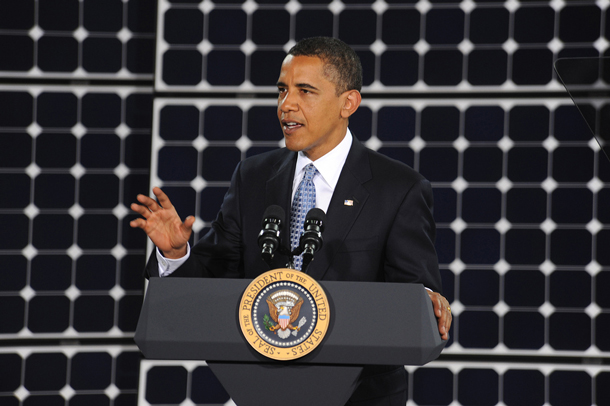
Former President Obama’s Clean Power Plan was key to his administration’s greenhouse gas reduction strategy for the U.S. Above, then-President Obama speaks about solar power during a visit to Nellis Air Force Base in Nevada, May 2009. (Photo: U.S. Air Force Photo/Senior Airman Brian Ybarbo, Flickr CC BY-ND 2.0)
CURWOOD: When they talk about repeal though, they make it sound like they're going to make it go away.
PARENTEAU: That's right. It sounds like this is the end of the road. It really isn’t. It's simply the beginning of another road.
CURWOOD: So, what could the EPA do to satisfy the requirement imposed by the United States Supreme Court to address carbon dioxide as a pollutant instead of the Obama-era Clean Power Plan?
PARENTEAU: Well, Pruitt has been known to advocate for regulating the power plants themselves, not beyond the fence line as it's called, and that would mean requiring better efficiency from these power plants which would result in a very modest reduction of emission. Something on the order of four percent is what EPA had estimated. And some environmental lawyers believe that Pruitt might be able to get by with such a minimal approach to regulating carbon. Others, including myself, think that the statute requires more and certainly the problem requires more than that. The statutory term that's at issue here is “the best” system of emission reduction, and certainly an emission reduction plan that only accomplishes a four percent reduction when much greater reductions are possible is not “the best”. So, I think there's a strong argument that if Pruitt takes the least restrictive approach to the problem, that could be vulnerable.
CURWOOD: So, to what extent is this move by Administrator Priutt really just a stall tactic to just keep the Clean Power Plan from moving forward?
PARENTEAU: That looks to be part of the strategy here, in part because in announcing the repeal of the rule, Pruitt also said he was going to open what's called an ‘advance notice of proposed rulemaking,” asking the open-ended question, “What do you think we should do about this problem of carbon pollution if anything?” And the announcement that he made, made it clear that he wasn't committing to actually proposing anything, and certainly not to a timeframe by which he would decide, so there is considerable speculation that, either by design or simply by running out of time, the first Trump Administration - and some would say hopefully the last - will not be able to accomplish actually completing a new rulemaking on a different plan. So, we're looking at a very long period of uncertainty for sure, several years.
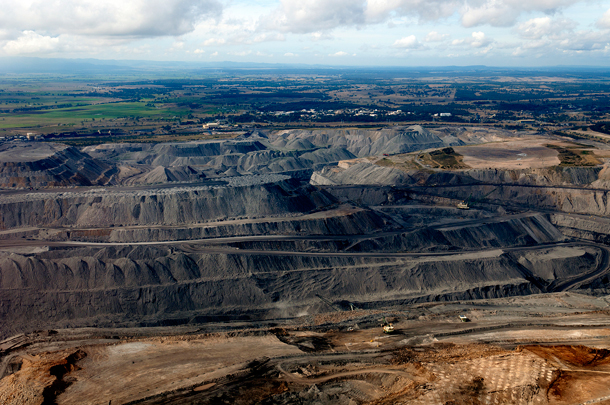
President Trump campaigned on a promise to breathe new life into the beleaguered coal industry. Yet cheap natural gas and renewable energy have been pushing coal aside for years. (Photo: Max Philipps (Jeremy Buckingham MLC), Flickr CC BY 2.0)
CURWOOD: So, what happens during this period of time? The original rule is in front of the US Circuit Court of Appeals there in DC. I imagine that that court and the other parties will have an opinion about this development.
PARENTEAU: Oh, yes, there definitely is going to be a petition for review once the repeal rule is final. The DC Circuit, of course, as we know has already received a large amount of briefing on these very same legal questions that are now posed by Pruitt's action. They heard a full day, eight hours of argument, and they heard the arguments as the full court. So, they've heard already, all of the issues and all of the arguments back and forth and probably are poised to render a decision on how this term and how this statute should be interpreted, whether it should be interpreted in the way that Pruitt wants to propose, which is the least restrictive it could be, or more closely aligned with what Obama proposed, which would have been about a 32 percent reduction in emissions by 2030.
CURWOOD: Now, the Obama Clean Power Plant set different standards for coal versus natural gas, and it only included large emitters. How fair was it to make it harder for coal to comply, and what about the smaller sources?
PARENTEAU: Well. coal is a third of our emissions, so it was clearly appropriate to zero in on coal-fired power plants as the primary sources that had to be controlled if we're going to get these emissions down to the levels that the science is telling us we need to. In fact, they need to go much further than what the Obama administration plan was proposing. Gas plants at the combustion stage are much less polluting than coal plants, so it won't be difficult for the gas-fired power plants to meet these new standards. In fact, gas is a key strategy in shifting from coal to cleaner sources, and smaller sources of emissions could also eventually become regulated. EPA was taking a sector by sector approach, starting with power plants, but there are many other industrial sectors that could also be the subject of carbon pollution regulation.
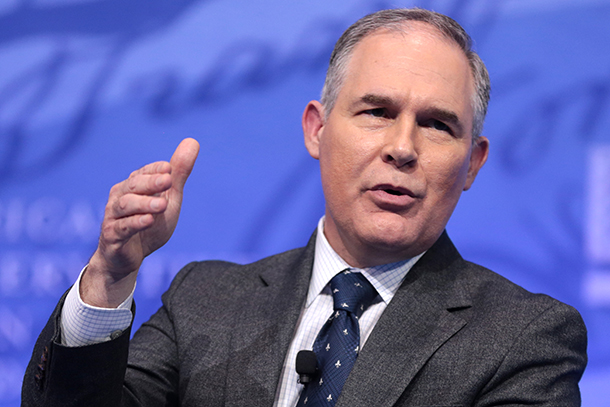
EPA Administrator Scott Pruitt. (Photo: Gage Skidmore, Flickr CC BY-SA 2.0)
So, EPA was faced with a major challenge, which was, as I say, a court decision saying they must regulate. A statute that says you should do it in the best system approach you can come up with, and I think EPA did a very credible job in looking at the grid system of America and saying, “Here are some flexible ways in which we can get these emissions down, continue to generate the electricity we need, keep the consumer rates low enough that people can afford the electricity”. They had to balance all of that and they had to come up with a plan that would actually work to achieve the reductions and not do unnecessary damage to our electricity system.
CURWOOD: Pat, Administrator Pruitt is on the record as being very skeptical of climate disruption and the human connection to it and such. How honest do you feel the administration's claim here is that, “Oh, the Clean Power Plan wouldn't really provide the health benefits that the law would require?”
PARENTEAU: Well, I think they're being very disingenuous. One of the great advantages of regulating these coal-fired power plants and shifting away, frankly, from coal is that you have tremendous health benefits from respiratory ailments, from asthma attacks, from people missing work, from premature death, from cardiovascular disease. There's really no dispute that coal is probably one of the most deadly forms of electricity generation we have in terms of the number of people that are exposed to these emissions. So, by reducing carbon we're also creating all these other health benefits. In this latest round of the proposal to repeal the Clean Power Plan, Pruitt and company have said we're not going to count any of those benefits because we don't think they're related to the carbon reduction goals of the statute, and that's pretty myopic and pretty backward way of thinking.
So, the science is getting stronger and stronger. We've seen what incredible monster storms climate change is creating with the four major hurricanes that have hit us just this season, and we're still not done, and the wildfires burning across the landscape of northern California. The climate scientists are drawing a clear link that these events are greater in terms of their intensity and damage than they would be without the global warming effect of all these greenhouse gases. So, everything that we see around us every day is telling us we need to move much more aggressively to reduce these emissions, and the Pruitt-Trump administration are marching in exactly the wrong direction.

Wind energy is already replacing some of the power grid needs previously met by coal-fired power plants. (Photo: Gord McKenna, Flickr CC BY-NC-ND 2.0)
CURWOOD: Pat, given that market forces - I'm talking here about a continued drop in the price of wind and solar and the flooding in the market with cheap natural gas -- we're already pushing out coal-fired power plants. How much of an impact do you think this bid to replace the Clean Power Plan will have on the nation's energy makeup?
PARENTEAU: Well, a lot of people do believe that we're going to achieve the goals of the Clean Power Plan even without it. In fact some recent studies suggest that we're already about two-thirds of the way to the 32 percent reduction goal that the Clean Power Plan was established. Even when that plan was approved, a lot of people were saying it was much too modest. It's pretty clear that we can do a lot better. We can get 40 or 50 percent, perhaps, if we really get serious about it. So, it may be that we'll accomplish these things even without the plan, but it's also true that the plan is going to cause some states, particularly those that are heavily dependent on coal, to continue to rely on coal instead of moving more aggressively off of it, and there may be some backsliding. It could be that gas prices start to increase and the operation of gas-fired power plants declines. So, the Clean Power Plan was kind of like a bulwark against maybe backsliding on some of these emission reductions that we are seeing.
CURWOOD: Hey, in making this announcement Pruitt says the EPA doesn't know yet whether it will promulgate a new rule. What's going on here? I mean, what's this calculation?
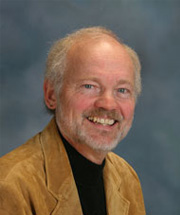
Pat Parenteau is a professor at the Vermont Law School, where he teaches on environmental litigation. (Photo: Vermont Law School)
PARENTEAU: Well, it seems to be a calculation to appease the coal industry. The coal industry wants no plan whatsoever, in fact, the coal industry has been persuading Secretary Perry at the Department of Energy to propose a rule that would require full cost recovery for coal and nuclear regardless of how much money a kilowatt of energy costs from a coal-fired power plant, they're going to be able to recover that. It's a major disruption of the energy market and it's all of a piece. I mean the repeal of the Clean Power Plan, this proposal to award the coal industry a subsidy in effect for full-cost recovery, at the same time that the natural gas is putting coal out of business, I mean this is a major national energy policy that's distorted beyond belief because instead of letting the market continue to operate and build more solar, more wind, more natural gas, cleaner energy sources, the Trump administration is actually trying to revive the coal industry when the market is determined to kill it.
CURWOOD: Pat Parenteau is a Professor of Law at Vermont Law School. Thanks so much for taking the time today, Pat.
PARENTEAU: You're welcome, Steve.
Links
Bloomberg: “Trump Administration Formally Proposes to Rescind Obama’s Clean Power Plan”
NYTimes: “E.P.A. Announces Repeal of Major Obama-Era Carbon Emissions Rule”
Living on Earth wants to hear from you!
Living on Earth
62 Calef Highway, Suite 212
Lee, NH 03861
Telephone: 617-287-4121
E-mail: comments@loe.org
Newsletter [Click here]
Donate to Living on Earth!
Living on Earth is an independent media program and relies entirely on contributions from listeners and institutions supporting public service. Please donate now to preserve an independent environmental voice.
NewsletterLiving on Earth offers a weekly delivery of the show's rundown to your mailbox. Sign up for our newsletter today!
 Sailors For The Sea: Be the change you want to sea.
Sailors For The Sea: Be the change you want to sea.
 The Grantham Foundation for the Protection of the Environment: Committed to protecting and improving the health of the global environment.
The Grantham Foundation for the Protection of the Environment: Committed to protecting and improving the health of the global environment.
 Contribute to Living on Earth and receive, as our gift to you, an archival print of one of Mark Seth Lender's extraordinary wildlife photographs. Follow the link to see Mark's current collection of photographs.
Contribute to Living on Earth and receive, as our gift to you, an archival print of one of Mark Seth Lender's extraordinary wildlife photographs. Follow the link to see Mark's current collection of photographs.
 Buy a signed copy of Mark Seth Lender's book Smeagull the Seagull & support Living on Earth
Buy a signed copy of Mark Seth Lender's book Smeagull the Seagull & support Living on Earth

